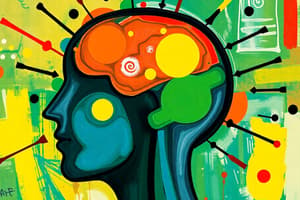Podcast
Questions and Answers
What is the main function of gas exchange in the lungs?
What is the main function of gas exchange in the lungs?
To ensure optimal oxygen levels for cellular function and remove CO₂
What drives the movement of oxygen and CO₂ in the alveolus?
What drives the movement of oxygen and CO₂ in the alveolus?
High concentration gradient
What is the significance of the surface area available for diffusion in gas exchange?
What is the significance of the surface area available for diffusion in gas exchange?
Efficiency of gas transfer
How do oxygen and CO₂ move across the alveolar membranes?
How do oxygen and CO₂ move across the alveolar membranes?
Describe the countercurrent mechanism in gas exchange.
Describe the countercurrent mechanism in gas exchange.
Explain the role of exhalation in the elimination of waste CO₂.
Explain the role of exhalation in the elimination of waste CO₂.
Where does the exchange of gases between atmospheric oxygen and blood primarily occur?
Where does the exchange of gases between atmospheric oxygen and blood primarily occur?
What are the key sites for gas exchange in the lungs?
What are the key sites for gas exchange in the lungs?
What is the primary site for gas exchange in the lungs?
What is the primary site for gas exchange in the lungs?
What are the thin walls surrounding the structures where gas exchange occurs called?
What are the thin walls surrounding the structures where gas exchange occurs called?
What is the process that occurs at the border between pulmonary capillaries and alveolar sacs?
What is the process that occurs at the border between pulmonary capillaries and alveolar sacs?
Why is the exchange of gases in the lungs essential for the human body?
Why is the exchange of gases in the lungs essential for the human body?
Flashcards are hidden until you start studying
Study Notes
Exhalation of Carbon Dioxide
Carbon dioxide is a common byproduct of cellular respiration, which occurs in all living organisms. In humans, it is produced when cells like mitochondria break down glucose to produce energy through a process called aerobic respiration. During this process, six molecules of glucose yield approximately 18 ATP (adenosine triphosphate) molecules and generate around 6 moles of CO₂. Although only trace amounts of water vapor escape from the body via exhalation compared to CO₂, both processes occur simultaneously during breathing.
The human body's capacity to expel CO₂ is essential to maintaining homeostasis. Unlike other mammals that can store CO₂ in their lung tissue until they exhale, human alveoli have limited storage capability due to their relatively small size. As a result, the respiratory system must continually eliminate excess CO₂ through exhalation. This requirement creates the need for adequate airflow through the lungs, which is facilitated by efficient gas transport pathways within the cardiovascular system.
Exchange of Gases in Lungs
Exchange of gases between atmospheric oxygen and blood happens primarily in the lungs. The key sites where these exchanges take place are the pulmonary capillaries and the alveolar sacs, with the primary site being the membranous structures at the border between the two, known as the respiratory bronchioles. These structures are surrounded by thin walls called alveolar membranes.
Gas exchange and ventilation occur in opposite directions across alveolar membranes, which are just one or two cells thick. Oxygen diffuses into the bloodstream through small capillaries from the lower portion of alveoli, while CO₂ moves outward into the larger airspaces. This countercurrent mechanism ensures effective oxygen uptake and CO₂ removal.
The efficiency of this gas transfer depends largely on the surface area available for diffusion, which is significant due to the extensive branching structure of the lung's airway tree. Additionally, the high concentration gradient of oxygen (PaO₂ = 150 mm Hg; PaCO₂ = 40 mm Hg) in the alveolus drives the movement of the respective gases in the desired direction.
In summary, the process of exhalation plays a crucial role in eliminating the waste product CO₂ from the human body. Efficient gas exchange in the lungs is responsible for this process, ensuring that the body maintains optimal oxygen levels for cellular function and removes CO₂ generated by metabolic activity.
Studying That Suits You
Use AI to generate personalized quizzes and flashcards to suit your learning preferences.




